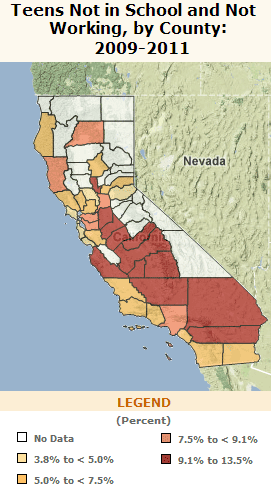Rates of Youth Not in School or Working Highest in Central Valley Counties
Nearly 200,000 California youth ages 16-19 were neither in school nor working in 2011, according to the latest estimates. The statewide percentage of "disconnected youth" – 8.7% – is up slightly from 8.2% in 2007. In counties with available data, more than half showed increases in the percentage of disconnected youth between 2005-07 and 2009-11.
Updated American Community Survey data now available on kidsdata.org also show wide variation in the percentage of disconnected youth throughout the state. Mirroring the slow economic recovery in the Central Valley, counties with the highest rates of disconnected youth were Merced (13.5%) and Kern (13.2%), among counties with 20,000+ residents in 2009-11. Counties with the lowest levels of youth disconnection were in the Bay Area, for example, Marin (4.3%) and Santa Cruz (3.8%).
See data by county >>
The Consequences and Costs to Communities
Disconnected youth face substantial barriers to achieving self-sufficiency. These youth are more likely to be poor, have academic problems, suffer from mental health issues, lack early work experience, and have children at a younger age than their peers.
For society at large, youth disconnection contributes to significant costs related to having an uneducated and unskilled workforce, increased crime and incarceration, and a greater need for public assistance.
Read more about why this matters and the policy implications of youth disconnection, and find related data.
New Legislation Introduced to Address Youth Disconnection
Stakeholders agree that it is critical to implement preventive measures that keep young people in school and/or employed, while also working to re-engage youth who have become disconnected. Several bills introduced in the current legislative session reflect this approach:
SB 730 (Hancock) – Middle College High Schools
This bill requires community college districts and high school districts to establish formal partnerships for the development of “middle college high schools.” These alternative high schools are located on community college campuses and are intended to help at-risk students graduate from high school and transition to college. The bill also would ensure that youth attending these schools are not charged fees and have priority enrollment in classes.
SB 744 (Lara) – Transfers to County Community Schools and Community Day Schools
This bill would limit probation referrals to community schools and allow a pupil to challenge a probation referral to a community school and request enrollment in another school. Community day schools are alternative schools run by school districts or county offices of education for students who have been expelled from school or who have had problems with attendance or behavior. The bill also would require community schools to provide additional academic support to pupils to ensure that they pass the high school exit exam.
AB 1152 (Ammiano) – California School Age Families Education Program
This bill protects funding for the California School Age Families Education Program (Cal-SAFE), by removing the program from the list of education programs that receive flexible funding that can be used for any educational purpose. Cal-SAFE is a comprehensive school-based program that improves the educational experiences for expectant and parenting pupils and their children. The program is designed to focus on dropout prevention, school success, and youth development through targeted supportive services and to provide child care and development services for the children of enrolled students.
AB 114 (Salas) – Proposition 39 Implementation: Clean Energy Job Creation Fund
This bill would require the Employment Development Department – using funds made available from the Clean Energy Job Creation Fund for job training and workforce development – to provide financial assistance to existing workforce development programs for the purposes of creating green energy jobs in California. It would require the California Conservation Corps, certified community conservation corps, YouthBuild, and other existing workforce development programs to give higher priority to disadvantaged youth and veterans who reside in an economically disadvantaged community or in a community with a higher unemployment rate than the statewide unemployment rate.
AB 1178 (Bocanegra) – California Promise Neighborhood Initiative
This bill would establish the California Promise Neighborhood Initiative to develop a system of 40 “promise neighborhoods” throughout the state to support children’s development from birth to career. High-need neighborhoods would be selected based on eligibility criteria and demonstrated ability to create a comprehensive, integrated continuum of services to improve academic achievement, including early childhood programs, child and youth social and health development, college and career readiness, and efforts to build strong family and community support.
H.R. 798: Workforce Investment Act (WIA) of 2013
This federal bill extends beyond youth but includes many aspects to help engage young people in multiple pathways to careers, including:
- Expanding access to work experience programs, including summer employment, internships, pre-apprenticeship programs, on-the-job training, and service activities.
- Amending the definition of disadvantaged youth to include youth through age 24.
- Requiring states to assess the needs of and serve youth with disabilities, including through job exploration and mentoring.
- Requiring that, at minimum, 60% of youth formula funds be spent on out-of-school youth.
- Authorizing the competitive Youth Innovation Fund, focused on areas of high youth unemployment and poverty, to spur the development of innovative strategies.
- Requiring all Job Corps Centers to meet and upgrade their standards of performance.
|

This map shows the estimated percentage of teens ages 16-19 who are not enrolled in school either full- or part-time and not working, although they may be looking for work. These teens are more likely than other youth to struggle with mental illness or substance abuse, encounter violence or become teen parents.
|

